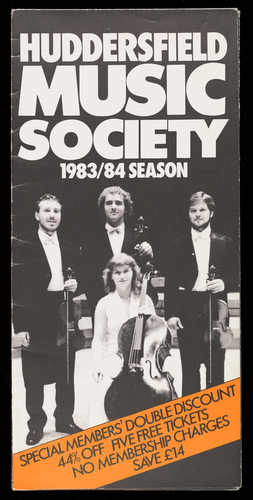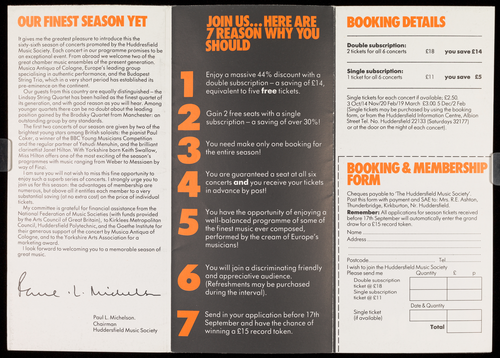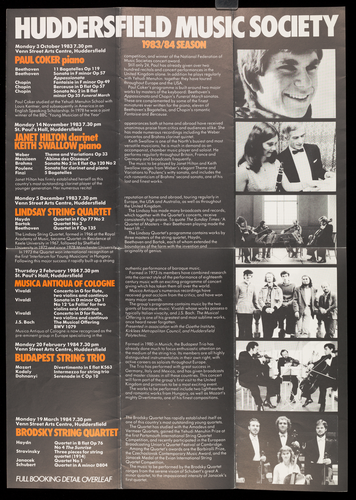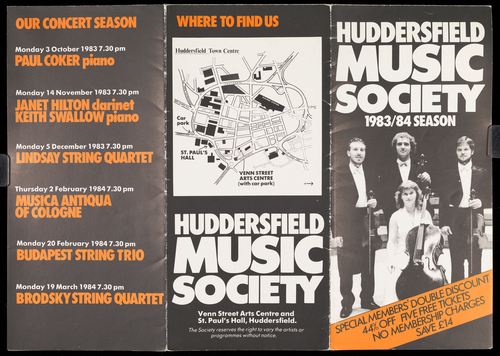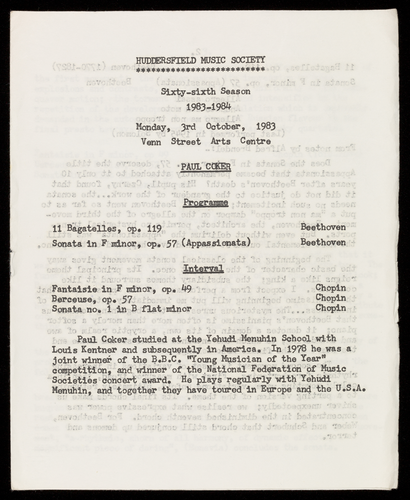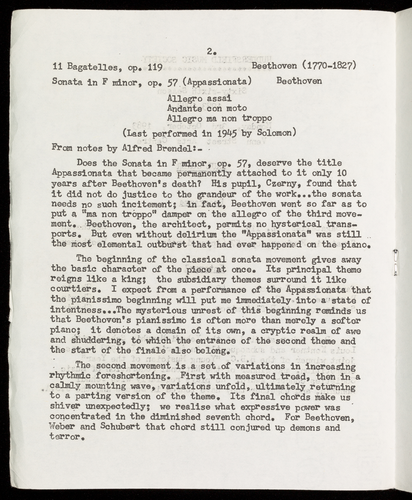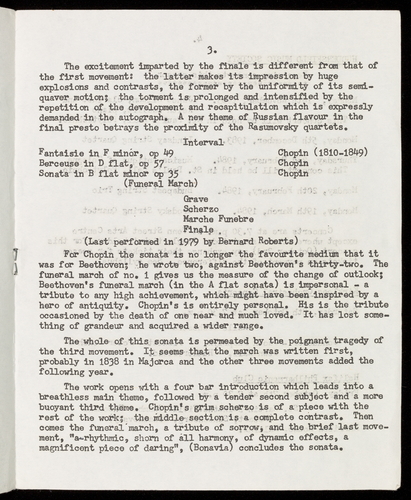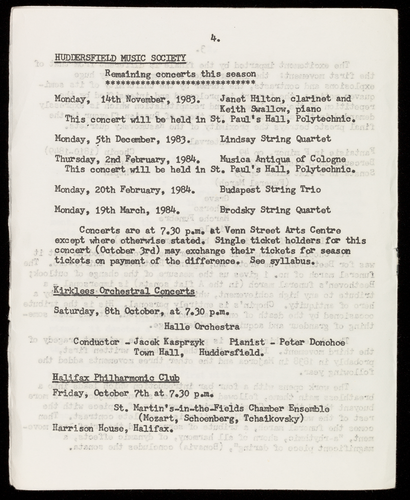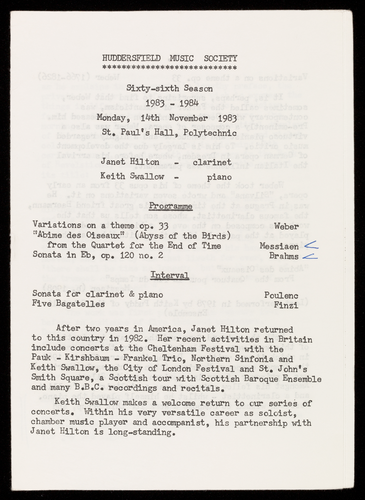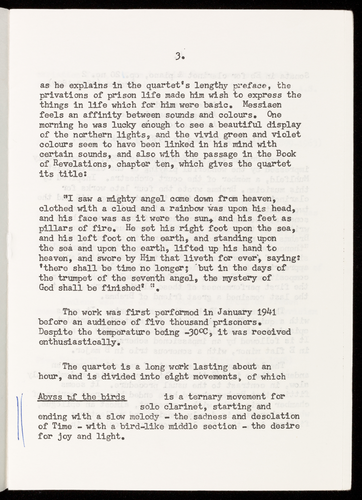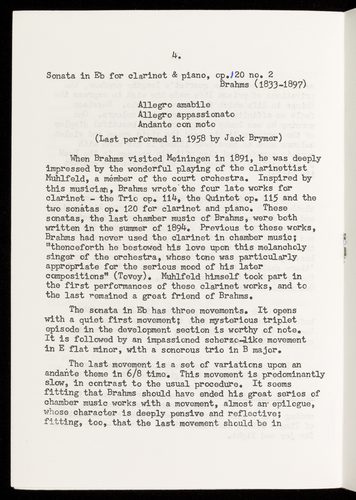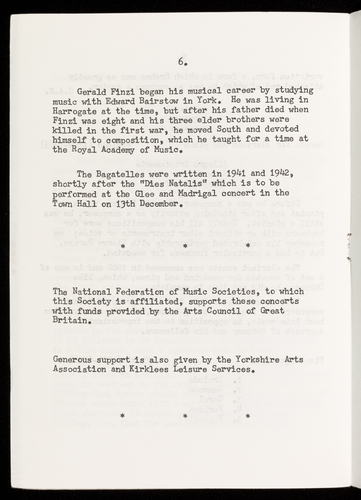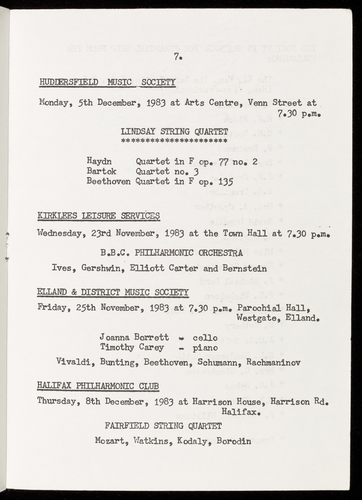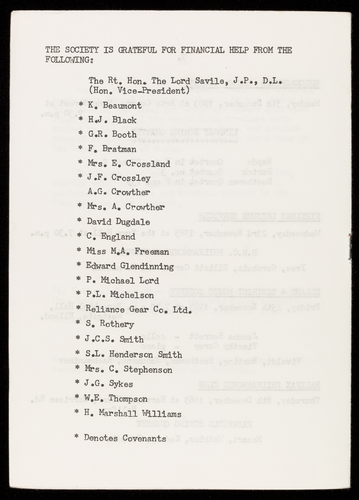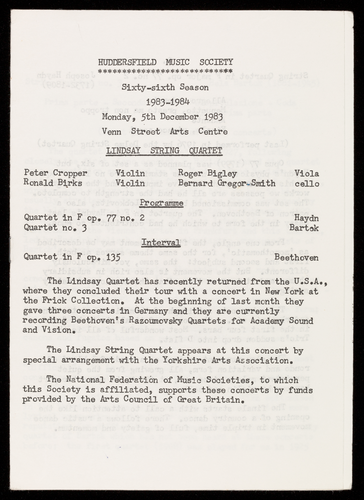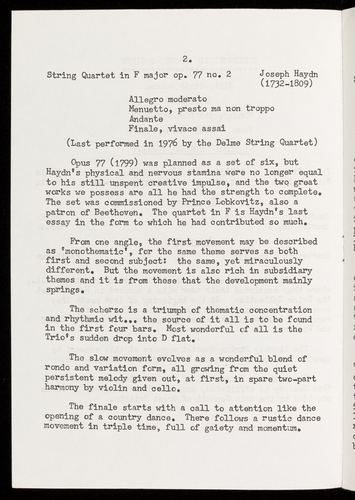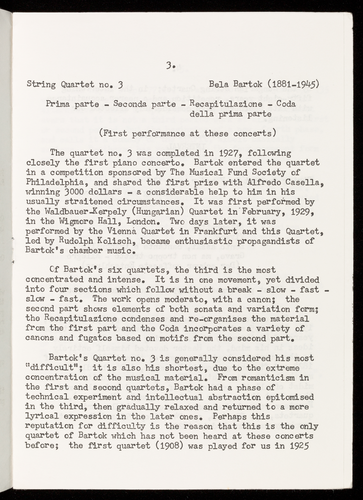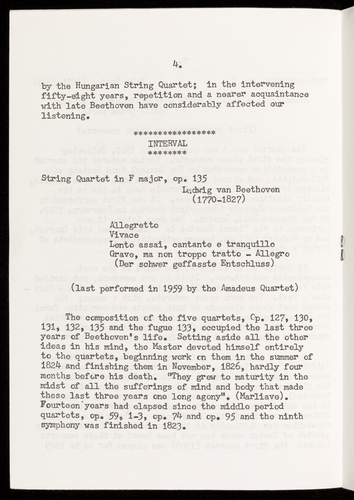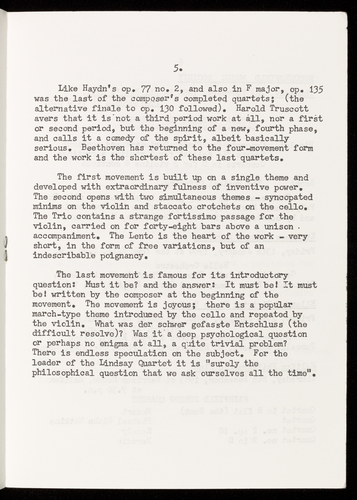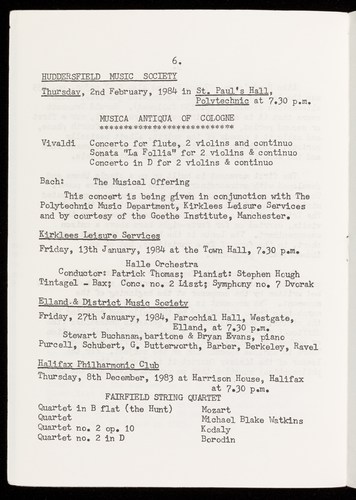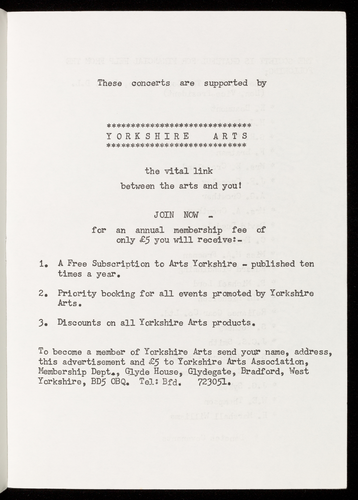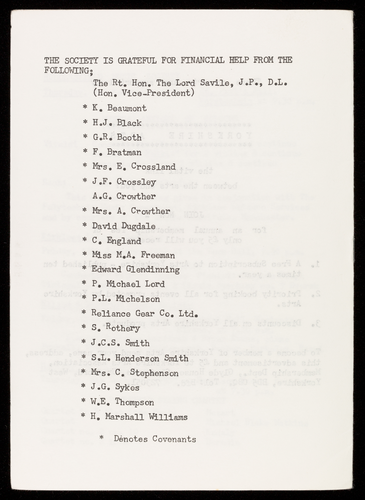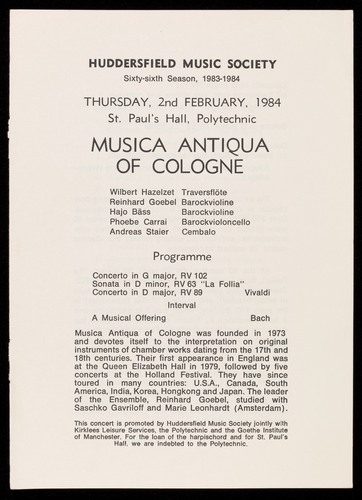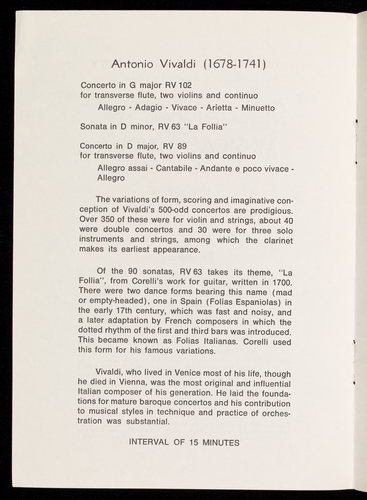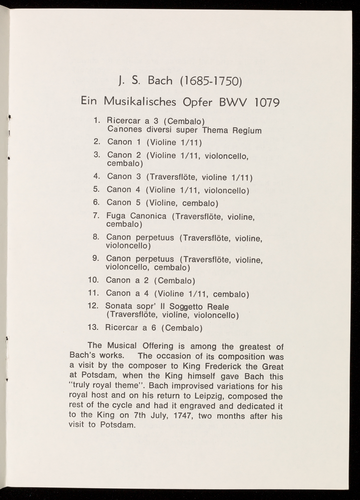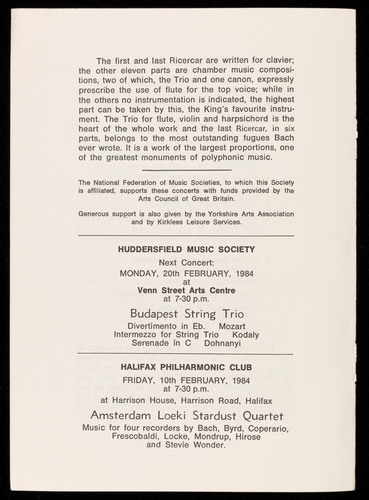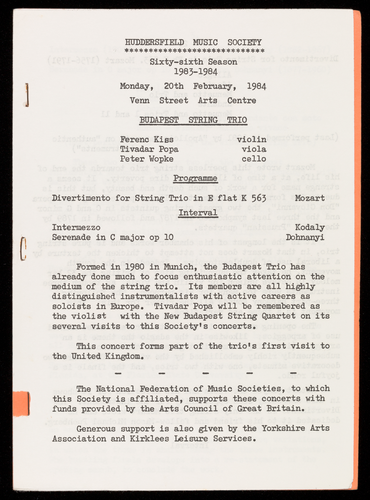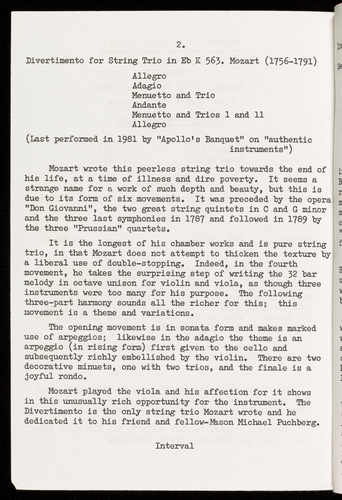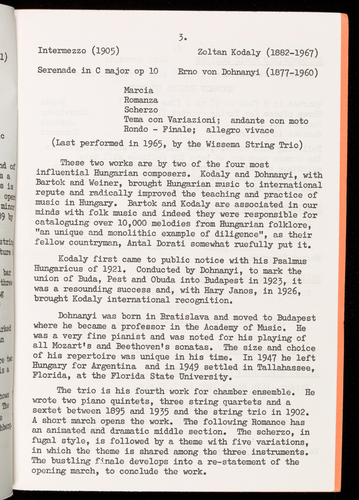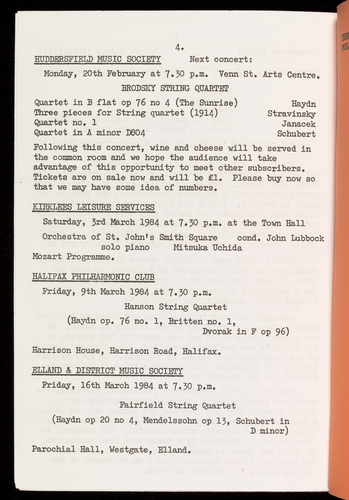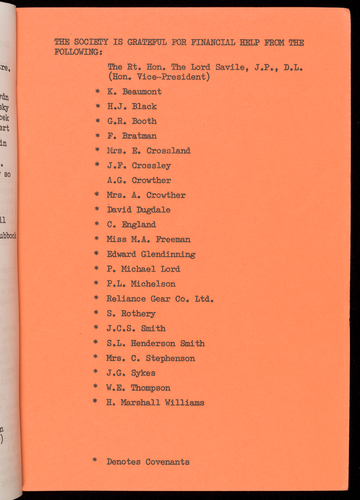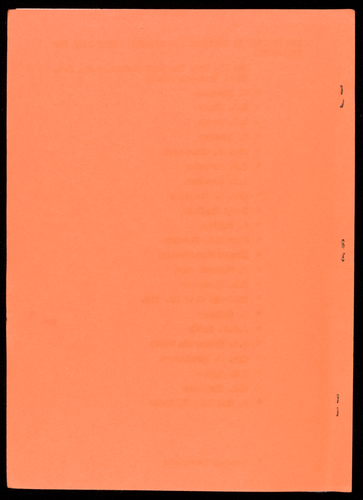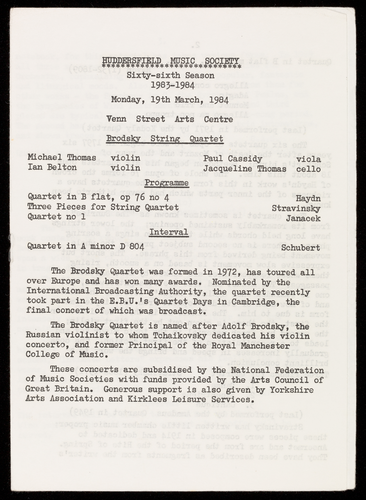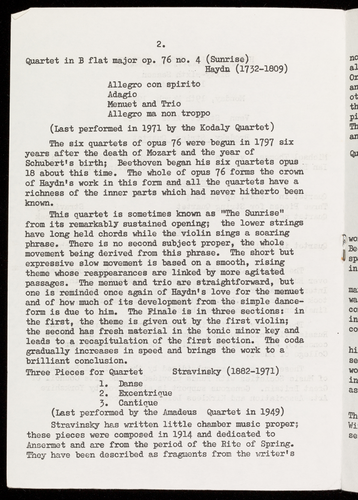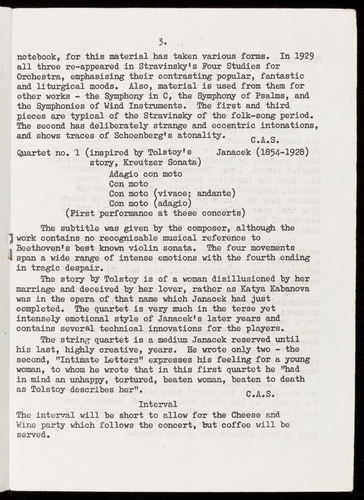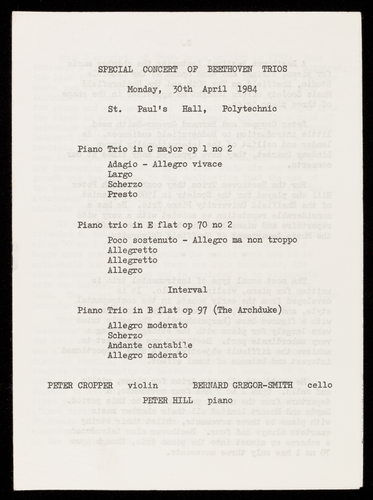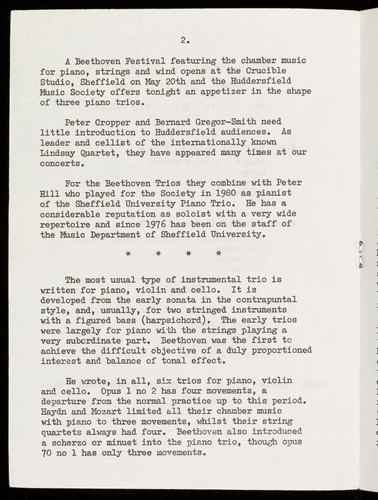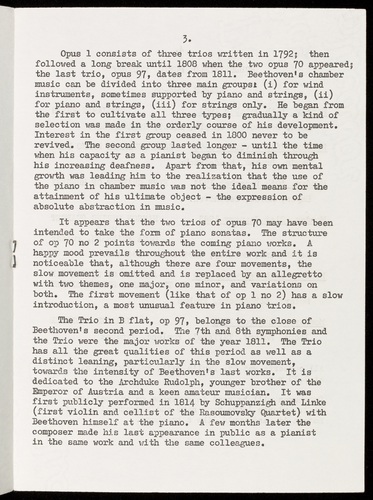Ocr'd Text:
HUDDERSFIELD
MUSIC
SOCIETY
1983/84 SEASON
*₁
IL
SPECIAL MEMBERS' DOUBLE DISCOUNT
44% OFF FIVE FREE TICKETS
SAVE £14
NO MEMBERSHIP CHARGES
Ocr'd Text:
OUR FINEST SEASON YET
It gives me the greatest pleasure to introduce this the
sixty-sixth season of concerts promoted by the Huddresfield
Music Society. Each concert in our programme promises to be
an exceptional event. From abroad we welcome two of the
great chamber music ensembles of the present generation.
Musica Antiqua of Cologne, Europe's leading group
specialising in authentic performance, and the Budapest
String Trio, which in a very short period has established its
pre-eminence on the continent.
Our guests from this country are equally distinguished - the
Lindsay String Quartet has been hailed as the finest quartet of
its generation, and with good reason as you will hear. Among
younger quartets there can be no doubt about the leading
position gained by the Brodsky Quartet from Manchester: an
outstanding group by any standards.
The first two concerts of our season are given by two of the
brightest young stars among British soloists: the pianist Paul
Coker, a winner of the BBC Young Musicians Competition
and the regular partner of Yehudi Menuhin, and the brilliant
clarinettist Janet Hilton. With Yorkshire born Keith Swallow,
Miss Hilton offers one of the most exciting of the season's
programmes with music ranging from Weber to Messiaen by
way of Finzi.
I am sure you will not wish to miss this fine opportunity to
enjoy such a superb series of concerts. I strongly urge you to
join us for this season: the advantages of membership are
numerous, but above all it entitles each member to a very
substantial saving (at no extra cost) on the price of individual
tickets.
My committee is grateful for financial assistance from the
National Federation of Music Societies (with funds provided
by the Arts Council of Great Britain), to Kirklees Metropolitan
Council, Huddersfield Polytechnic, and the Goethe Institute for
their generous support of the concert by Musica Antiqua of
Cologne, and to the Yorkshire Arts Association for a
marketing award.
I look forward to welcoming you to a memorable season of
great music.
fame . L. Michels
и
Paul L. Michelson.
Chairman
Huddersfield Music Society
23
4
5
6
7
JOIN US... HERE ARE
7 REASON WHY YOU
SHOULD
Enjoy a massive 44% discount with a
double subscription - a saving of £14,
equivalent to five free tickets.
Gain 2 free seats with a single
subscription - a saving of over 30%!
You need make only one booking for
the entire season!
You are guaranteed a seat at all six
concerts and you receive your tickets
in advance by post!
You have the opportunity of enjoying a
well-balanced programme of some of
the finest music ever composed,
performed by the cream of Europe's
musicians!
You will join a discriminating friendly
and appreciative audience.
(Refreshments may be purchased
during the interval).
Send in your application before 17th
September and have the chance of
winning a £15 record token.
BOOKING DETAILS
Double subscription:
2 tickets for all 6 concerts
Single subscription:
1 ticket for all 6 concerts
£18
£11
Single tickets for each concert if available; £2.50.
3 Oct/14 Nov/20 Feb/19 March £3.00. 5 Dec/2 Feb
(Single tickets may be purchased by using the booking
form, or from the Huddersfield Information Centre, Albion
Street Tel. No. Huddersfield 22133 (Saturdays 32177)
or at the door on the night of each concert).
Double subscription
ticket @ £18
Single subscription
ticket @ £11
you save £14
you save £5
BOOKING & MEMBERSHIP
FORM
Single ticket
(if available)
Cheques payable to 'The Huddersfield Music Society'.
Post this form with payment and SAE to: Mrs. R.E. Ashton,
Thunderbridge, Kirkburton, Nr. Huddersfield.
Remember: All applications for season tickets received
before 17th September will automatically enter the grand
draw for a £15 record token.
|
Name .......
Address
Postcode........
Tel......
I wish to join the Huddersfield Music Society
Please send me
Quantity
Date & Quantity
Total
£
р
Ocr'd Text:
HUDDERSFIELD MUSIC SOCIETY
Monday 3 October 1983 7.30 pm
Venn Street Arts Centre, Huddersfield
PAUL COKER piano
Beethoven
Beethoven
Chopin
Chopin
Chopin
Paul Coker studied at the Yehudi Menuhin School with
Louis Kentner, and subsequently in America in an
English Speaking Scholarship. In 1978 he was a joint
winner of the BBC 'Young Musician of the Year'
Weber
Messiaen
Brahms
Poulenc
Finzi
Monday 14 November 1983 7.30 pm
St. Paul's Hall, Huddersfield
JANET HILTON clarinet
KEITH SWALLOW piano
11 Bagatelles Op 119
Sonata in F minor Op 57
Appassionata
Fantaisie in F minor Op 49
Berceuse in D flat Op 57
Sonata No 2 in B flat
minor Op 35 Funeral March
Janet Hilton has firmly established herself as this
country's most outstanding clarinet player of the
younger generation. Her numerous recital
Haydn
Bartok
Beethoven
Monday 5 December 1983 7.30 pm
Venn Street Arts Centre, Huddersfield
LINDSAY STRING QUARTET
Quartet in F Op 77 No 2
Quartet No 3
Quartet in F Op 135
Theme and Variations Op 33
'Abime des Oiseaux'
Sonata No 2 in E flat Op 120 No 2
Sonata for clarinet and piano
5 Bagatelles
Vivaldi
The Lindsay String Quartet, formed in 1966 at the Royal
Academy of Music, became Quartet-in-Residence at
Keele University in 1967, followed by Sheffield
University in 1972 and since 1978 Manchester University.
In 1973 the Quartet won international recognition at
the first 'Interforum for Young Musicians' in Hungary.
Following this major success it rapidly built up a strong
Thursday 2 February 1984 7.30 pm
St. Paul's Hall, Huddersfield
MUSICA ANTIQUA OF COLOGNE
Vivaldi
Vivaldi
Concerto in G for flute,
two violins and continuo
Sonata in D minor Op 1
No 12'La Follia' for two
violins and continuo
Concerto in D for flute,
two violins and continuo
The Musical Offering
BWV 1079
J.S. Bach
Musica Antiqua of Cologne is now recognised as the
pre-eminent group in Europe specialising in the
Mozart
Kodaly
Dohnanyi
Monday 20 February 1984 7.30 pm
Venn Street Arts Centre, Huddersfield
BUDAPEST STRING TRIO
Haydn
Stravinsky
Janacek
Schubert
Divertimento in E flat K563
Intermezzo for string trio
Serenade in C Op 10
Monday 19 March 1984 7.30 pm
Venn Street Arts Centre, Huddersfield
Quartet in B flat Op 76
No 4 The Sunrise
Three pieces for string
quartet (1914)
Quartet No 1
Quartet in A minor D804
1983/84 SEASON
competition, and winner of the National Federation of
Music Societies concert award.
Still only 24, Paul has already given over two
hundred recitals and concert performances in the
United Kingdom alone. In addition he plays regularly
with Yehudi Menuhin: together they have toured
throughout Europe and the USA.
Paul Coker's programme is built around two major
works by masters of the keyboard: Beethoven's
Appassionata and Chopin's Funeral March sonatas.
These are complemented by some of the finest
miniatures ever written for the piano, eleven of
Beethoven's Bagatelles, and Chopin's romantic
Fantaisie and Berceuse.
FULL BOOKING DETAIL OVERLEAF
appearances both at home and abroad have received
unanimous praise from critics and audiences alike. She
has made numerous recordings including the Weber
concertos and Brahms clarinet quintet.
Keith Swallow is one of the North's busiest and most
versatile musicians; he is much in demand as an
accompanist, chamber music player and soloist. Hel
performs regularly throughout Britain, France and
Germany and broadcasts frequently.
The music to be played by Janet Hilton and Keith
Swallow ranges from Weber's elegant Theme and
Variations to Poulenc's witty sonata, and includes the
rich romanticism of Brahms' second sonata, one of his
last and finest works.
reputation at home and abroad, touring regularly in
Europe, the USA and Australia, as well as throughout
the United Kingdom.
The Lindsay has made many broadcasts and records,
which together with the Quartet's concerts, receive
consistently high praise. To quote The Sunday Times: 'A
Quartet of Masters - their Beethoven playing made the
heart lift ...'
The Lindsay Quartet's programme contains works by
three masters of the string quartet, Haydn,
Beethoven and Bartok, each of whom extended the
boundaries of the form with the invention and
originality of genius.
authentic performance of baroque music.
Formed in 1973 its members have combined research
into the correct style of the performance of eighteenth
century music with an exciting programme of concert
giving which has taken them all over the world.
Musica Antiqua's numerous recordings have
received great acclaim from the critics, and have won
many major awards.
The group's programme contains music by the two
giants of baroque music: Vivaldi whose works possess a
typically Italian vivacity, and J.S. Bach. The Musical
Offering is one of his greatest and most sublime works,
once heard never forgotten.
The Brodsky Quartet has rapidly established itself as
one of this country's most outstanding young quartets.
The Quartet has studied with the Amadeus and
BRODSKY STRING QUARTET Vermeer Quartets, gained the Yehudi Menuhin Prize at
the first
String Quartet
Competition, and recently participated in the European
Broadcasting Union's Quartet Festival at Cambridge.
Presented in association with the Goethe Institute,
Kirklees Metropolitan Council, and Huddersfield
Polytechnic.
Formed in 1980 in Munich, the Budapest Trio has
already done much to focus enthusiastic attention on
the medium of the string trio. Its members are all highly
distinguished instrumentalists in their own right, with
active careers as soloists throughout Europe.
The Trio has performed with great success in
Germany, Italy and Mexico, and has given broadcasts
and master classes in all these countries. This concert
will form part of the group's first visit to the United
Kingdom and promises to be a most exciting event.
The works to be performed include two lighthearted
and romantic works from Hungary, as well as Mozart's
mighty Divertimento, one of his finest compositions.
Among the Quartet's awards are the Barbirolli Prize,
the Czechoslovak Contemporary Music Award, and the
Janacek Medal at the Evian International String
Quartet Competition.
The music to be performed by the Brodsky Quartet
ranges from the serene vision of Schubert's great A
minor quartet, to the impassioned intensity of Janacek's
first quartet.
WELL SALL
...
Ocr'd Text:
OUR CONCERT SEASON
Monday 3 October 1983 7.30 pm
PAUL COKER piano
Monday 14 November 1983 7.30 pm
JANET HILTON clarinet
KEITH SWALLOW piano
Monday 5 December 1983 7.30 pm
LINDSAY STRING QUARTET
Thursday 2 February 1984 7.30 pm
MUSICA ANTIQUA
OF COLOGNE
Monday 20 February 1984 7.30 pm
BUDAPEST STRING TRIO
Monday 19 March 1984 7.30 pm
BRODSKY STRING QUARTET
WHERE TO FIND US
Huddersfield Town Centre
NCHESTER ROAD A62
A616 CHAPEL HILL
Car
park
QUEEN ST. STA.
ST. PAUL'S
HALL
QUEENSGATE
CASTLEGATE
JO
A629 WAKEFIELD ROAD
2-
SOUTHGATE
NEW
RAILWAY STATION
VENN STREET
ARTS CENTRE
(with car park)
NORTH ROAD
LEEDS ROAD A62
Venn Street Arts Centre and
St. Paul's Hall, Huddersfield.
ST JOHN'S
RD
z→→
HUDDERSFIELD
MUSIC
SOCIETY
The Society reserves the right to vary the artists or
programmes without notice.
HUDDERSFIELD
MUSIC
SOCIETY
1983/84 SEASON
ik
SPECIAL MEMBERS' DOUBLE DISCOUNT
44% OFF FIVE FREE TICKETS
SAVE £14
NO MEMBERSHIP CHARGES
Ocr'd Text:
(VS81-0yyt) nevod
novoritool
HUDDERSFIELD MUSIC SOCIETY
****.qo ceffetagad it
(adsnotee Bagà) 2.40 onim 1 at stano
Sixty-sixth Season
OTSATTA
2
odom 1983-1984
20
oqqot nom am oIIA
Monday,
Venn
3rd
October, 1983
(nomolo 200 NE DEMTO lveq fasi)
21
Street Arts Centre
Lebror benA yd setort so
eftit od evrozob
I
PAUL COKER i stano2 od 2000
Of vino db of boriosida menstieg omsoed tedt stenoiaa sqqÀ
tadt bawol yates Itqug al disob a'novodtee sedis annoy
stance adj...now end to webasrg odt of softant, ob dom blb ti
of as net oa fnow novodteel Programme remedioni dove og absor
-ovom batdd odd to orgelfs odd no toqmab "oggott non em s Jug
11 Bagatelles, op. 119 g Joodidors ed novor Beethovenom
Ita
shortesagh odt uttlob duodd hw nove jud
son Sonata in F minor, op. 57 (Appassionata) o Isten Beethoven
Vawe zovig #homevom stanoa Isotassio od to gatanfged of
omorit Isatontag atI .one Intervalors to rejostedo ofasd odt
oxif ji bavote semont vrstbiedra ont aids off angior
JanFantaisie in F minor, op. 491oqa mort Jooqxo I . Chopin
to Berceuse, op. 57etbormt om Jug fit anfaniged omtee Chopin t
a Sonata no. 1 in B flat minore auoietav od... Chopin
tolice s fotom nert otom nofto at onfee instq a'novodjool dari
owe to misox oldayo s wo att to nismob s setonob 3 sonstq
brs Paul Coker studied at the Yehudi Menuhin School with bas
Louis Kentner and subsequently in America. In 1978 he was at
joint winner of the B.B.C. "Young Musician of the Year"
competition, and winner of the National Federation of Music
Societies concert award. He plays regularly with Yehudi
Menuhin, and together they have toured in Europe and the U.S.A.
note v gaidisq
aew ovog ovlazeqe Jaw setisen ow ylbetoogxent revide
Nevorteel to broro dinevee bene inimib end at bedente onco
bas anomeb qu benutnoo Ide brodo dadt Jedudo bas redel
av ex bodo Isni
emədi
TOTOJ
Ocr'd Text:
2.
YTISCE DIRUM CITEASCICUL
11 Bagatelles, op. 119.
Sonata in F minor,
Beethoven (1770-1827)
op. 57. (Appassionata) Beethoven
x 12
Allegro assai
Andante con moto
Allegro ma non troppo
BRONE
reboo
(Last performed in 1945 by Solomon)
90
From notes by Alfred Brendel:-
Does the Sonata in F minor, op. 57, deserve the title
Appassionata that became permanently attached to it only 10
years after Beethoven's death? His pupil, Czerny, found that
it did not do justice to the grandeur of the work...the sonata
needs no such incitement; in fact, Beethoven went so far as to
put a "ma non troppo" damper on the allegro of the third move-
ment... Beethoven, the architect, permits no hysterical trans-
ports. But even without delirium the "Appassionata" was still
the most elemental outburst that had ever happened on the piano.
The beginning of the classical sonata movement gives away
the basic character of the piece at once. Its principal theme
reigns like a king; the subsidiary themes surround it like
courtiers. I expect from a performance of the Appassionata that
the pianissimo beginning will put me immediately into a state of
intentness...The mysterious unrest of this beginning reminds us
that Beethoven's pianissimo is often more than merely a softer
piano; it denotes a domain of its own, a cryptic realm of awe
and shuddering, to which the entrance of the second theme and
the start of the finale also belong.
e bas tominell atuol
agody jutot
The second movement is a set of variations in increasing
rhythmic foreshortening. First with measured tread, then in a
calmly mounting wave, variations unfold, ultimately returning
to a parting version of the theme. Its final chords make us
shiver unexpectedly; we realise what expressive power was
concentrated in the diminished seventh chord. For Beethoven,
Weber and Schubert that chord still conjured up demons and
terror.
Ocr'd Text:
3.
YTHTO02 012IN AUT
The excitement imparted by the finale is different from that of
the first movement: the latter makes its impression by huge
explosions and contrasts, the former by the uniformity of its semi-
quaver motion; the torment is prolonged and intensified by the
repetition of th
the development and recapitulation whic
development and recapitulation which is expressly
demanded in the autograph. A new theme of Russian flavour in the
final presto betrays the proximity of the Rasumovsky quartets.
Jedren godt year Interval 801edmoood divebooki
Fantaisie in F minor, op 49
Berceuse in D flat, op 57 fa
Sonata in B flat minor op 35
(Funeral March)
Jeogebra
T
Chopin (1810-1849)
48enChopin beh
at bied od Chopin
e
II
Chopinfoo GANT
4801 Vodo dios ysboll
Grave
m2 plebo Scherzo
todo
med et JooseFinale. 06. de one atracnob
(Last performed in 1979 by Bernard Roberts) Joxe
4801 none dei vabroll
Marche Funebre
aid
e wrote two, against Beethoven's thirty-two. The
For Chopin the sonata is no longer the favourite medium that it
was for Beethoven;
funeral march of no. 1 gives us the measure of the change of outlook;
Beethoven's funeral march (in the A flat sonata) is impersonal - a
tribute to any high achievement, which might have been inspired by a
hero of antiquity. Chopin's is entirely personal. His is the tribute
occasioned by the death of one near and much loved. It has lost some-
thing of grandeur and acquired a wider range.
The whole of this sonata is permeated by the poignant tragedy of
the third movement. It seems that the march was written first,
probably in 1838 in Majorca and the other three movements added the
following year.
The work opens with a four bar introduction which leads into a
breathless main theme, followed by a tender second subject and a more
buoyant third theme. Chopin's grim scherzo is of a piece with the
rest of the work; the middle section is a complete contrast. Then
comes the funeral march, a tribute of sorrow, and the brief last move-
ment, "a-rhythmic, shorn of all harmony, of dynamic effects, a
magnificent piece of daring", (Bonavia) concludes the sonata.
Ocr'd Text:
Io
HUDDERSFIELD MUSIC SOCIETY
**
E
BISHE dd yd bettaqui nomodtoxe erfl
Remaining concerts this season :dremevom Janti edi
********** etaaxtnoo has anotaofqxe
*******
4.
vleesiaxe af do
vizë
NO IN
edt
be
Monday, 14th November, 1983.Janet Hilton, clarinet and vap
Keith Swallow, piano noteger
en This concert will be held in St. Paul's Hall, Polytechnic.smeb
Jou eup plavomidas ent viimixo to ed avended odaetq Lenti
Monday, 5th December, 1983.Evie Lindsay String Quartet
(Q481-0181) igodo
mont It efetsins!
Tel
Thursday, 2nd February, 1984. Musica Antiqua of Cologne
This concert will be held in St. Paul's Hall, Polytechnic. No
(Coral Ienenu!)
Budapest String Trio
Monday, 20th February, 1984.
Monday, 19th March, 1984.
endom
SVAID
osted Brodsky String Quartet
odorsM
Concerts are at 7.30 p.m. at Venn Street Arts Centre
except where otherwise stated, Single ticket holders for this
concert (October 3rd) may exchange their tickets for season
tickets on payment of the difference. See syllabus.es tot asw
2200 [two to egredo ort to evasom odd er eevią I
edd ar esvia I on to focos Istou?
Iagoeneant at (stenoa dalt A ont at) dos Istomut a 'nevondeof
Kirklees Orchestral Concerts removo idos dat we of studied
studiat odt at et Tanpatog vferire at a'riqod vtiupitns to orod
Saturday, 8th October, at 7.30 p.m. to disab edt yd berolasooo
doo
w
.Halle Orchestratupos bue webasty to gahit
to begs Conductor - Jacek Kasprzyk Pianist - Peter Donohoe
nettbw Town Hall,
dan
Huddersfield.
Jremevom babit ed
et bobbs etnomevos eordt vendo en bas soote mt 881 nt vida do tq
e
Teey antwo[fot
Halifax Philharmonic Club
Philh
Norw no R portat ad suot a fthe enego Now off.
Friday, October 7th at 7.30 p.m. bewo Lotomont nism eas Intserd
ont diw sosie St. Martin's-in-the-Fields Chamber Ensemble dnsyond
medT
Jastroo edel(Mozart, Schoenberg, Tchaikovsky)ow end to Jast
-evon Harrison House, Halifax.on to studi dotam Istort ont cemoo
safoelte omarryb toyromisd IIs 10 roda oddi-s" nom
stanos ort esbufonos (atvano)"tab to ooolg nooihingan
seno O
Ocr'd Text:
HUDDERSFIELD MUSIC SOCIETY
(assi-dəri) edell
stoals a
bebraget t
drongo Leve
Sixty-sixth Season
100
1983 1984
EE
me to
amid boane Monday, 14th November 1983
Janet Hilton
Keith Swallow
***
s no enolistus V
St. Paul's Hall, Polytechnic
Din
Sonata for clarinet & piano
Five Bagatelles
clarinet
piano
vise ne m
dood redeW
itetev novoz ototy bre "snev[12"
8 broll Jao Programme
it Jant au aflet noe o
Variations on a theme op. 33 ve ord mo
"Abime des Oiseaux" (Abyss of the Birds)
from the Quartet for the End of Time
Sonata in Eb, op. 120 no. 2
Interval
menime
TOUJAUQ
doo Weber
Messiaen <
Brahms <
asb onida
Poulenc
vbbil dial yd 8yet mt berrol Finzi
After two years in America, Janet Hilton returned
to this country in 1982. Her recent activities in Britain
include concerts at the Cheltenham Festival with the
Pauk
Kirshbaum Frankel Trio, Northern Sinfonia and
Keith Swallow, the City of London Festival and St. John's
Smith Square, a Scottish tour with Scottish Baroque Ensemble
and many B.B.C. recordings and recitals.
on
Keith Swallow makes a welcome return to our series of
concerts. Within his very versatile career as soloist,
chamber music player and accompanist, his partnership with
Janet Hilton is long-standing.
Ocr'd Text:
YTETDOR OT 2. 03
Variations on a theme op. 33
Weber (1766-1826)
It is, perhaps, surprising to find that Weber,
sometimes called the Father of Romanticism, was
contemporary with Beethoven and even pre-deceased him.
Pre-eminently a composer of opera, Weber was also a
virtuoso pianist and conductor and a highly regarded
music critic. To him is largely due the development
of German opera in Dresden, where before his arrival
the Italian influence was paramount.
Weber took the theme of his opus 33 from an early
opera, "Silvana" and wrote seven variations on it. He
was in Prague at the time, with his great friend Baermann,
the famous clarinettist, whose son tells us that the
work was composed on the eve of a big party and was
played at the party by his father, with Weber at the
piano.
"Abime des Oiseaux"
From the Quatuor pour la fin du Temps"
Messiaen (b. 1908)
(Last performed in 1978 by Keith Puddy of the Gabrieli
Ensemble)
00
Both the outward form and the inward inspiration
of this work were greatly influenced by the circumstances
in which it was written. During the years 1940 to 1942
the French composer Messiaen (then in his early thirties)
was a prisoner of war in a prison camp in Silesia.
Amongst his fellow prisoners was a violinist, a 'cellist
and a clarinettist whilst he himself played the piano.
Messiaen wished to compose a work for this group, and
Ocr'd Text:
3.
as he explains in the quartet's lengthy preface, the
privations of prison life made him wish to express the
things in life which for him were basic. Messiaen
feels an affinity between sounds and colours. One
morning he was lucky enough to see a beautiful display
of the northern lights, and the vivid green and violet
colours seem to have been linked in his mind with
certain sounds, and also with the passage in the Book
of Revelations, chapter ten, which gives the quartet
its title:
bea
tofarm atd
fo
end "I saw a mighty angel come down from heaven,
clothed with a cloud and a rainbow was upon his head,
and his face was as it were the sun, and his feet as
pillars of fire. He set his right foot upon the sea,
and his left foot on the earth, and standing upon
the sea and upon the earth, lifted up his hand to
heaven, and swore by Him that liveth for ever, saying:
there shall be time no longer; but in the days of
the trumpet of the seventh angel, the mystery of
God shall be finished
CR
SME
The work was first performed in January 1941
before an audience of five thousand prisoners.
Despite the temperature being -30°C, it was received go
enthusiastically.
The quartet is a long work lasting about an
hour, and is divided into eight movements, of which abge
Abyss of the birds
is a ternary movement for
solo clarinet, starting and
ending with a slow melody - the sadness and desolation
of Time with a bird-like middle section the desire
for joy and light.
Ocr'd Text:
4.
Sonata in Eb for clarinet & piano, op.120 no. 2
Brahms (1833-1897)
obsm
Allegro amabile do
Loo Allegro appassionato
Andante con moto
(Last performed in 1958 by Jack Brymer) on to
When Brahms visited Meiningen in 1891, he was deeply
impressed by the wonderful playing of the clarinettist
Muhlfeld, a member of the court orchestra. Inspired by
this musician, Brahms wrote the four late works for
clarinet - the Trio op. 114, the Quintet op. 115 and the
two sonátas op. 120 for clarinet and piano. These
sonatas, the last chamber music of Brahms, were both
written in the summer of 1894. Previous to these works,
Brahms had never used the clarinet in chamber music;
"thenceforth he bestowed his love upon this melancholy
singer of the orchestra, whose tone was particularly
appropriate for the serious mood of his later
compositions" (Tovey). Muhlfeld himself took part in
the first performances of these clarinet works, and to
the last remained a great friend of Brahms.
It opens
The sonata in Eb has three movements.
with a quiet first movement; the mysterious triplet
episode in the development section is worthy of note.
It is followed by an impassioned scherzo-like movement
in E flat minor, with a sonorous trio in B major.
The last movement is a set of variations upon an
andante theme in 6/8 time. This movement is predominantly
slow, in contrast to the usual procedure. It seems
fitting that Brahms should have ended his great series of
chamber music works with a movement, almost an epilogue,
whose character is deeply pensive and reflective;
fitting, too, that the last movement should be in
to
Ocr'd Text:
5.
variation form, a form to which Brahms was so greatly
attached and of which he was so supreme a master. C.A.S.
********
INTERVAL
Sonata for clarinet and piano
*
Five Bagatelles
bas fo
Allegro tristamente
Romanza
Allegro con fuoco
bas eo ID od ta ben
g
Before he was a composer, Francis Poulenc was a
pianist and after attaining maturity as a composer, he was
still a pianist. Nearly all his compositions were for
keyboard with or without other instruments or voice; we
remember his celebrated partnership with Pierre Bernac.
But he had a particular fondness for woodwind.
Poulenc (1899-1963)
The clarinet sonata was composed in 1962 and is one of
a set of sonatas for woodwind and piano, which, like
Debussy, he did not live to complete.
1. Prelude
2. Romance
3. Carol
4. Forlana
5. Fughetta
Poulenc was one of "les Six"- the group of French
composers who sought to bring humour, clarity and lyricism
back into music, in opposition to the impressionist
approach of Debussy and his followers.
08 Finzi (1901-1956) D
Ocr'd Text:
VI
6.
laina
2.A. Gerald Finzi began his musical career by studying
music with Edward Bairstow in York. He was living in
Harrogate at the time, but after his father died when
Finzi was eight and his three elder brothers were
killed in the first war, he moved South and devoted
himself to composition, which he taught for a time at
the Royal Academy of Music.
ew geotov
no
The Bagatelles were written in 1941 and 1942,
shortly after the "Dies Natalis" which is to be
performed at the Glee and Madrigal concert in the
Town Hall on 13th December.
*
ta
The National Federation of Music Societies, to which de
this Society is affiliated, supports these concerts
with funds provided by the Arts Council of Great
Britain.molesont ent
Generous support is also given by the Yorkshire Artsv
Association and Kirklees Leisure Services.
Ocr'd Text:
7.
HUDDERSFIELD MUSIC SOCIETY
Haydn
Bartok
Monday, 5th December, 1983 at Arts Centre, Venn Street at
7.30 p.m.
LINDSAY STRING QUARTET
*****
RI
Quartet in F op. 77 no. 2
Quartet no. 3
Beethoven Quartet in F op. 135
KIRKLEES LEISURE SERVICES
Wednesday, 23rd November, 1983 at the Town Hall at 7.30 p.m.
B.B.C. PHILHARMONIC ORCHESTRA
Ives, Gershwin, Elliott Carter and Bernstein
ELLAND & DISTRICT MUSIC SOCIETY
Friday, 25th November, 1983 at 7.30 p.m. Parochial Hall,
Westgate, Elland.
Joanna Borrett
Timothy Carey
Vivaldi, Bunting, Beethoven, Schumann, Rachmaninov
cello
piano
HALIFAX PHILHARMONIC CLUB
Thursday, 8th December, 1983 at Harrison House, Harrison Rd.
Halifax.
FAIRFIELD STRING QUARTET
Mozart, Watkins, Kodaly, Borodin on
Ocr'd Text:
THE SOCIETY IS GRATEFUL FOR FINANCIAL HELP FROM THE
FOLLOWING:
The Rt. Hon. The Lord Savile, J.P., D.L.
(Hon. Vice-President)
is doo K, Beaumont
*
* K.
* H.J. Black
* G.R. Booth
* F. Bratman
* Mrs. E. Crossland od sou
i
* J.F. Crossley
A.G. Crowther
*
* Mrs. A. Crowther
DIVAGE UII INATA
* David Dugdale
OC.C. England en de tochvoll Syabaombol
6801
* Miss M.A. Freeman
* Edward Glendinning jokatdated sevi
VI
* P. Michael Lord
*P.L. Michelson
H* Reliance Gear Co. Ltd. er rednovoll rides
* S. Rothery
* J.C.S. Smith
* S.L. Henderson Smith
TRACTOR
* Mrs. C. Stephenson
* J.G. Sykes
.b nost* W.E. Thompson
*W.E.
*H. Marshall Williams
2801 doood die ysbrolf
TO
Denotes Covenants
1002 DT8UM TOTTI (MALESI
Vous
all
ob
vdjoměT
BUTO DIMOMAAHIIHI XAZILIAH
Thompson da 8e1 Todine od d8ysbedT
Bl
8tblsvtV
Ocr'd Text:
abysH riqesob
HUDDERSFIELD MUSIC SOCIETY
**
oggo non
Sixty-sixth Season
Peter Cropper on
Ronald Birks odi
of
COM
Monday, 5th December 1983
Venn Street Arts Centre
P
1983-1984
7910
(dodreu) iute med
LINDSAY STRING
x
ejelambo of digne
Is
QUARTET
Quartet in F op. 77 no. 2
Quartet no. 3
m
**
Programme bonorea
Iq
Viola
Violin e Roger Bigley olayda
Violin th Bernard Gregor Smith ancello
Jeju grija
molted Jes)
onT novorfood to
Interval edt eigns en
Haydn
Bartok
evra omed emn
omne
Quartet in F op. 135
hyov
omse ond
tbladue ni dobi oals at treme
The Lindsay Quartet has recently returned from the U.S.A.,
where they concluded their tour with a concert in New York at
the Frick Collection. At the beginning of last month they
gave three concerts in Germany and they are currently
recording Beethoven's Razoumovsky Quartets for Academy Sound
and Vision. Its to Introbnow Jeol azad ol Janit odt at
ord Tol'oltamontcom!
Joot dua baoose bree
Beethoven
The Lindsay String Quartet appears at this concert by
special arrangement with the Yorkshire Arts Association.
Jetup odj
Le m
The National Federation of Music Societies, to which
this Society is affiliated, supports these concerts by funds
provided by the Arts Council of Great Britain.
Ocr'd Text:
2.
String Quartet in F major op. 77 no. 2
Joseph Haydn
(1732-1809)
Allegro moderato
Menuetto, presto ma non troppo
Andante
Finale, vivace assai
(Last performed in 1976 by the Delme String Quartet)
Opus 77 (1799) was planned as a set of six, but
Haydn's physical and nervous stamina were no longer equal
to his still unspent creative impulse, and the two great
works we possess are all he had the strength to complete.
The set was commissioned by Prince Lobkovitz, also a
patron of Beethoven. The quartet in F is Haydn's last
essay in the form to which he had contributed so much.
From one angle, the first movement may be described
as 'monothematic', for the same theme serves as both edero
first and second subject: the same, yet miraculously
different. But the movement is also rich in subsidiary
themes and it is from these that the development mainly
springs.
The scherzo is a triumph of thematic concentrationsg
and rhythmic wit... the source of it all is to be found
in the first four bars. Most wonderful of all is the
Trio's sudden drop into D flat.
The slow movement evolves as a wonderful blend of loca
rondo and variation form, all growing from the quiet
persistent melody given out, at first, in spare two-part
harmony by violin and cello.
The finale starts with a call to attention like the
opening of a country dance. There follows a rustic dance
movement in triple time, full of gaiety and momentum.
C
t
Ocr'd Text:
3.
String Quartet no. 3
Bela Bartok (1881-1945)
Prima parte - Seconda parte - Recapitulazione - Coda
della prima parte
(First performance at these concerts)
The quartet no. 3 was completed in 1927, following
closely the first piano concerto. Bartok entered the quartet
in a competition sponsored by The Musical Fund Society of
Philadelphia, and shared the first prize with Alfredo Casella,
winning 3000 dollars - a considerable help to him in his
usually straitened circumstances. It was first performed by
the Waldbauer-Kerpely (Hungarian) Quartet in February, 1929,
in the Wigmore Hall, London. Two days later, it was
performed by the Vienna Quartet in Frankfurt and this Quartet,
led by Rudolph Kolisch, became enthusiastic propagandists of
Bartok's chamber music.
Of Bartok's six quartets, the third is the most.
concentrated and intense. It is in one movement, yet divided
into four sections which follow without a break slow fast
slow fast. The work opens moderato, with a canon; the
second part shows elements of both sonata and variation form;
the Recapitulazione condenses and re-organises the material
from the first part and the Coda incorporates a variety of
canons and fugatos based on motifs from the second part.
Bartok's Quartet no. 3 is generally considered his most
"difficult"; it is also his shortest, due to the extreme
concentration of the musical material. From romanticism in
the first and second quartets, Bartok had a phase of
technical experiment and intellectual abstraction epitomised
in the third, then gradually relaxed and returned to a more
lyrical expression in the later ones. Perhaps this
reputation for difficulty is the reason that this is the only
quartet of Bartok which has not been heard at these concerts
before; the first quartet (1908) was played for us in 1925
Ocr'd Text:
by the Hungarian String Quartet; in the intervening
fifty-eight years, repetition and a nearer acquaintance
with late Beethoven have considerably affected our
listening.
dedi
(atroo
4.
****
INTERVAL
********
***
String Quartet in F major, op. 135
E
ed
Ludwig van Beethoven
(1770-1827)
Allegretto
Vivace
to adelbagage Lento assai, cantante e tranquillo
Grave, ma non troppo tratto - Allegro
(Der schwer geffasste Entschluss)
dant (last performed in 1959 by the Amadeus Quartet)
IsoThe composition of the five quartets, Op. 127, 130,
131, 132, 135 and the fugue 133, occupied the last three
years of Beethoven's life. Setting aside all the other cono
ideas in his mind, the Master devoted himself entirely
to the quartets, beginning work on them in the summer of
1824 and finishing them in November, 1826, hardly four
months before his death. They grew to maturity in the no
midst of all the sufferings of mind and body that made
these last three years one long agony". (Marliave).
Fourteen years had elapsed since the middle period
quartets, op. 59, 1-3, op. 74 and op. 95 and the ninth
symphony was finished in 1823.
Ocr'd Text:
5.
DH
Like Haydn's op. 77 no. 2, and also in F major, op. 135
was the last of the composer's completed quartets;
(the
alternative finale to op. 130 followed). Harold Truscott
avers that it is not a third period work at áll, nor a first
or second period, but the beginning of a new, fourth phase,
and calls it a comedy of the spirit, albeit basically
serious. Beethoven has returned to the four-movement form
and the work is the shortest of these last quartets.
The first movement is built up on a single theme and
developed with extraordinary fulness of inventive power.
The second opens with two simultaneous themes- syncopated
minims on the violin and staccato crotchets on the cello.
The Trio contains a strange fortissimo passage for the ba
violin, carried on for forty-eight bars above a unison.
accompaniment. The Lento is the heart of the work very
short, in the form of free variations, but of an
indescribable poignancy.
I
The last movement is famous for its introductory
question: Must it be? and the answer: It must be! It must
be! written by the composer at the beginning of the
movement. The movement is joyous;
there is a popular
march-type theme introduced by the cello and repeated by
the violin. What was der schwer gefasste Entschluss (the
difficult resolve)? Was it a deep psychological question
or perhaps no enigma at all, a quite trivial problem?
There is endless speculation on the subject. For the
leader of the Lindsay Quartet it is "surely the
philosophical question that we ask ourselves all the time".
vaba tul
8
Ocr'd Text:
HUDDERSFIELD MUSIC SOCIETY
masy
Thursday, 2nd February, 1984 in St. Paul's Hall,
Polytechnic at 7.30 p.m.
6.
MUSICA ANTIQUA OF COLOGNE
*****
**
Bach:
********
Vivaldi Concerto for flute, 2 violins and continuo
Sonata "La Follia" for 2 violins & continuo
Concerto in D for 2 violins & continuo
The Musical Offering
Leveb
This concert is being given in conjunction with The
Polytechnic Music Department, Kirklees Leisure Services
and by courtesy of the Goethe Institute, Manchester.
Kirklees Leisure Services
Friday, 13th January, 1984 at the Town Hall, 7.30 p.m.
Halle Orchestra
Conductor: Patrick Thomas;
Pianist: Stephen Hough
Tintagel Bax; Conc. no. 2 Liszt; Symphony no. 7 Dvorak
Elland & District Music Society
Friday, 27th January, 1984, Parochial Hall, Westgate,
Elland, at 7.30 p.m.
Stewart Buchanan, baritone & Bryan Evans, piano
Purcell, Schubert, G. Butterworth, Barber, Berkeley, Ravel
Halifax Philharmonic Club
Thursday, 8th December, 1983 at Harrison House, Halifax
at 7.30 p.m.
FAIRFIELD STRING QUARTET
Quartet in B flat (the Hunt)
Quartet
Quartet no. 2 op. 10
Quartet no. 2 in D
Mozart
Michael Blake Watkins
Kodaly
Borodin
Ocr'd Text:
These concerts are supported by
for
YORKSHIRE ARTS
*******
**
the vital link
between the arts and you!
JOIN NOW
****
an annual membership fee
only £5 you will receive:--
1. A Free Subscription to Arts Yorkshire published ten
times a year.
2. Priority booking for all events promoted by Yorkshire
Arts.
3. Discounts on all Yorkshire Arts products.
HJ 142
To become a member of Yorkshire Arts send your name, address,
this advertisement and 5 to Yorkshire Arts Association,
Membership Dept., Glyde House, Glydegate, Bradford, West
Yorkshire, BD5 OBQ. Tel: Bfd. 723051.
Ocr'd Text:
THE SOCIETY IS GRATEFUL FOR FINANCIAL HELP FROM THE
FOLLOWING;
The Rt. Hon. The Lord Savile, J.P., D.L.
(Hon. Vice-President)
* K. Beaumont
* H.J. Black
* G.R. Booth
* F. Bratman
* Mrs. E. Crossland
* J.F. Crossley es el necuted
A.G. Crowther
* Mrs. A. Crowther
* David Dugdale todo stints ne
* C. England oot ILw voy 23 yino
* Miss M.A. Freeman
not bede Edward Glendinning
*
*P. Michael Lord
P.L. Michelson evo Ils not goblood vol
*Reliance Gear Co. Ltd.
ubong atal ext
* S. Rothery
* J.C.S. Smith
azosoba * S.L. Henderson Smith
en
v² est A
*
Jedto to
23 bas Juomoeid tovbs etdi
* Mrs. C. Stephens on canol obyged girlatrodimelf
208 video Y
* J.G. Sykes
* W.E. Thompson
* H, Marshall Williams
Dènotes Covenants
.E
Ocr'd Text:
HUDDERSFIELD MUSIC SOCIETY
Sixty-sixth Season, 1983-1984
THURSDAY, 2nd FEBRUARY, 1984
St. Paul's Hall, Polytechnic
MUSICA ANTIQUA
coviy OF COLOGNE
Wilbert Hazelzet Traversflöte
Reinhard Goebel Barockvioline
Barockvioline
Barockvioloncello
Hajo Bäss
Phoebe Carrai
Andreas Staier
Cembalo
Programme
Concerto in G major, RV 102
Sonata in D minor, RV 63 "La Follia"
Concerto in D major, RV 89
Interval
Vivaldi
A Musical Offering
Bach
Musica Antiqua of Cologne was founded in 1973
and devotes itself to the interpretation on original
instruments of chamber works dating from the 17th and
18th centuries. Their first appearance in England was
at the Queen Elizabeth Hall in 1979, followed by five
concerts at the Holland Festival. They have since
toured in many countries: U.S.A., Canada, South
America, India, Korea, Hongkong and Japan. The leader
of the Ensemble, Reinhard Goebel, studied with
Saschko Gavriloff and Marie Leonhardt (Amsterdam).
This concert is promoted by Huddersfield Music Society jointly with
Kirklees Leisure Services, the Polytechnic and the Goethe Institute
of Manchester. For the loan of the harpischord and for St. Paul's
Hall, we are indebted to the Polytechnic.
Ocr'd Text:
Antonio Vivaldi (1678-1741)
Concerto in G major RV 102
for transverse flute, two violins and continuo
Allegro Adagio Vivace - Arietta - Minuetto
Sonata in D minor, RV 63 "La Follia"
Concerto in D major, RV 89
for transverse flute, two violins and continuo
B
Allegro assai Cantabile Andante e poco vivace -
Allegro
The variations of form, scoring and imaginative con-
ception of Vivaldi's 500-odd concertos are prodigious.
Over 350 of these were for violin and strings, about 40
were double concertos and 30 were for three solo
instruments and strings, among which the clarinet
makes its earliest appearance.
Of the 90 sonatas, RV 63 takes its theme, "La
Follia", from Corelli's work for guitar, written in 1700.
There were two dance forms bearing this name (mad
or empty-headed), one in Spain (Folias Espaniolas) in
the early 17th century, which was fast and noisy, and
a later adaptation by French composers in which the
dotted rhythm of the first and third bars was introduced.
This became known as Folias Italianas. Corelli used
this form for his famous variations.
Vivaldi, who lived in Venice most of his life, though
he died in Vienna, was the most original and influential
Italian composer of his generation. He laid the founda-
tions for mature baroque concertos and his contribution
to musical styles in technique and practice of orches-
tration was substantial.
INTERVAL OF 15 MINUTES
Ocr'd Text:
J. S. Bach (1685-1750)
Ein Musikalisches Opfer BWV 1079
1. Ricercar a 3 (Cembalo)
Canones diversi super Thema Regium
2. Canon 1 (Violine 1/11)
3. Canon 2 (Violine 1/11, violoncello,
cembalo)
4.
Canon 3 (Traversflöte, violine 1/11)
5. Canon 4 (Violine 1/11, violoncello)
6. Canon 5 (Violine, cembalo)
7. Fuga Canonica (Traversflöte, violine,
cembalo)
8. Canon perpetuus (Traversflöte, violine,
violoncello)
9. Canon perpetuus (Traversflöte, violine,
violoncello, cembalo)
10. Canon a 2 (Cembalo)
11. Canon a 4 (Violine 1/11, cembalo)
12. Sonata sopr' Il Soggetto Reale
(Traversflöte, violine, violoncello)
13. Ricercar a 6 (Cembalo)
The Musical Offering is among the greatest of
Bach's works. The occasion of its composition was
a visit by the composer to King Frederick the Great
at Potsdam, when the King himself gave Bach this
"truly royal theme". Bach improvised variations for his
royal host and on his return to Leipzig, composed the
rest of the cycle and had it engraved and dedicated it
to the King on 7th July, 1747, two months after his
visit to Potsdam.
Ocr'd Text:
The first and last Ricercar are written for clavier;
the other eleven parts are chamber music composi-
tions, two of which, the Trio and one canon, expressly
prescribe the use of flute for the top voice; while in
the others no instrumentation is indicated, the highest
part can be taken by this, the King's favourite instru-
ment. The Trio for flute, violin and harpsichord is the
heart of the whole work and the last Ricercar, in six
parts, belongs to the most outstanding fugues Bach
ever wrote. It is a work of the largest proportions, one
of the greatest monuments of polyphonic music.
The National Federation of Music Societies, to which this Society
is affiliated, supports these concerts with funds provided by the
Arts Council of Great Britain.
Generous support is also given by the Yorkshire Arts Association
and by Kirklees Leisure Services.
HUDDERSFIELD MUSIC SOCIETY
Next Concert:
MONDAY, 20th FEBRUARY, 1984
at
Venn Street Arts Centre
at 7-30 p.m.
Budapest String Trio
Mozart
Divertimento in Eb.
Intermezzo for String Trio Kodaly
Serenade in C Dohnanyi
HALIFAX PHILHARMONIC CLUB
FRIDAY, 10th FEBRUARY, 1984
at 7-30 p.m.
at Harrison House, Harrison Road, Halifax
Amsterdam Loeki Stardust Quartet
Music for four recorders by Bach, Byrd, Coperario,
Frescobaldi, Locke, Mondrup, Hirose
and Stevie Wonder.
Ocr'd Text:
1
C
HUDDERSFIELD MUSIC SOCIETY
*
(reyr-deyr) so Sixty-sixth Season
a ameoa I
****
1983-1984
20th February, 1984
Monday, 20th
Foun
Venn Street Arts Centre
C
olinodius" no Ferenc Kiss
(1
("adnemo Tivadar Popa
Peter Wopke
BUDAPEST STRING
vď 28rf at be
Intermezzo
Serenade in C major op 10
y
TRIO
violinomolzeq fanl)
violin
viola
cello
Programme lo
12
Divertimento for String Trio in E flat K 563
Interval
01 Mozarteub
Dohnanyi
Kodalyerit
trf
This concert forms part of the trio's first visit to
the United Kingdom.
volom
Formed in 1980 in Munich, the Budapest Trio has ITE
already done much to focus enthusiastic attention on the
medium of the string trio. Its members are all highly
distinguished instrumentalists with active careers as
soloists in Europe. Tivadar Popa will be remembered as
the violist with the New Budapest String Quartet on its
several visits to this Society's concerts.
The National Federation of Music Societies, to which
this Society is affiliated, supports these concerts with
funds provided by the Arts Council of Great Britain.
MA
Generous support is also given by the Yorkshire Arts
Association and Kirklees Leisure Services.
Ocr'd Text:
YTT1003 TDI 2.
Divertimento for String Trio in Eb K 563. Mozart (1756-1791)
Allegro
Adagio
Menuetto and Trio
Andante
Menuetto and Trios 1 and 11
Allegro
(Last performed in 1981 by "Apollo's Banquet" on "authentic
instruments")
Mozart wrote this peerless string trio towards the end of
his life, at a time of illness and dire poverty. It seems a
strange name for a work of such depth and beauty, but this is
due to its form of six movements. It was preceded by the opera
"Don Giovanni", the two great string quintets in C and G minor
and the three last symphonies in 1787 and followed in 1789 by
the three "Prussian" quartets.
It is the longest of his chamber works and is pure string
trio, in that Mozart does not attempt to thicken the texture by
a liberal use of double-stopping. Indeed, in the fourth
movement, he takes the surprising step of writing the 32 bar
melody in octave unison for violin and viola, as though three
instruments were too many for his purpose. The following
three-part harmony sounds all the richer for this;
movement is a theme and variations.
this
The opening movement is in sonata form and makes marked
use of arpeggios; likewise in the adagio the theme is an
arpeggio (in rising form) first given to the cello and
subsequently richly embellished by the violin. There are two
decorative minuets, one with two trios, and the finale is a
joyful rondo.
Mozart played the viola and his affection for it shows
in this unusually rich opportunity for the instrument. The
Divertimento is the only string trio Mozart wrote and he
dedicated it to his friend and fellow-Mason Michael Puchberg.
Interval
In
Se
B
r
B
B
C
11
H
V
W
t
a
Ocr'd Text:
1)
C
and of
sa
s is
oper
minor
39 by
string
ture
bar
three
g
rked
an
re two
is a
hows
The
e
hberg
Intermezzo (1905)
Serenade in C major op 10
Marcia
Romanza
Scherzo
3.
Zoltan Kodaly (1882-1967)
naom
Erno von Dohnanyi (1877-1960)
Tema con Variazioni; andante con moto
Rondo Finale; allegro vivace
(Last performed in 1965, by the Wissema String Trio)
These two works are by two of the four most
influential Hungarian composers. Kodaly and Dohnanyi, with
Bartok and Weiner, brought Hungarian music to international
repute and radically improved the teaching and practice of
music in Hungary. Bartok and Kodaly are associated in our
minds with folk music and indeed they were responsible for
cataloguing over 10,000 melodies from Hungarian folklore,
"an unique and monolithic example of diligence", as their
fellow countryman, Antal Dorati somewhat ruefully put it.
Kodaly first came to public notice with his Psalmus
Hungaricus of 1921. Conducted by Dohnanyi, to mark the
union of Buda, Pest and Obuda into Budapest in 1923, it
was a resounding success and, with Hary Janos, in 1926,
brought Kodaly international recognition.
Dohnanyi was born in Bratislava and moved to Budapest
where he became a professor in the Academy of Music. He
was a very fine pianist and was noted for his playing of
all Mozart's and Beethoven's sonatas. The size and choice
of his repertoire was unique in his time. In 1947 he left
Hungary for Argentina and in 1949 settled in Tallahassee,
Florida, at the Florida State University.
The trio is his fourth work for chamber ensemble. He
wrote two piano quintets, three string quartets and a
sextet between 1895 and 1935 and the string trio in 1902.
A short march opens the work. The following Romance has
an animated and dramatic middle section. The scherzo, in
fugal style, is followed by a theme with five variations,
in which the theme is shared among the three instruments.
The bustling finale develops into a re-statement of the
opening march, to conclude the work.
Ocr'd Text:
4.
HUDDERSFIELD MUSIC SOCIETY
Next concert:
Monday, 20th February at 7.30 p.m. Venn St. Arts Centre.
BRODSKY STRING QUARTET
Quartet in B flat op 76 no 4 (The Sunrise)
Three pieces for String quartet (1914)
Quartet no. 1
Quartet in A minor D804
Following this concert, wine and cheese will be served in
the common room and we hope the audience will take
advantage of this opportunity to meet other subscribers.
Tickets are on sale now and will be £l. Please buy now so
that we may have some idea of numbers.
KIRKLEES LEISURE SERVICES
Saturday, 3rd March 1984 at 7.30 p.m. at the Town Hall
Orchestra of St. John's Smith Square
cond. John Lubbock
solo piano
Mozart Programme.
Mitsuka Uchida
HALIFAX PHILHARMONIC CLUB
Friday, 9th March 1984 at 7.30 p.m.
Hanson String Quartet
(Haydn op. 76 no. 1, Britten no. 1,
Haydn
Stravinsky
Janacek
Schubert
Harrison House, Harrison Road, Halifax.
Dvorak in F op 96)
ELLAND & DISTRICT MUSIC SOCIETY
Friday, 16th March 1984 at 7.30 p.m.
Parochial Hall, Westgate, Elland.
Fairfield String Quartet
(Haydn op 20 no 4, Mendelssohn op 13, Schubert in ora
D minor)
WHE
FOL
Ocr'd Text:
cre.
dn
sky
cek
ert
in
7 SO
11
ubbock
m
)
THE SOCIETY IS GRATEFUL FOR FINANCIAL HELP FROM THE
FOLLOWING:
* K. Beaumont
* H.J. Black
* G.R. Booth
* F. Bratman
* Mrs. E. Crossland
J.F. Crossley
A.G. Crowther
Mrs. A. Crowther
David Dugdale
*
The Rt. Hon. The Lord Savile, J.P., D.L.
(Hon. Vice-President)
*
* C. England
* Miss M.A. Freeman
*
* P.L. Michelson
* Reliance Gear Co. Ltd.
* S. Rothery
*
Edward Glendinning
P. Michael Lord
J.C.S. Smith
S.L. Henderson Smith
* Mrs. C. Stephenson
*
J.G. Sykes
* W.E. Thompson
* H. Marshall Williams
*
*Denotes Covenants
Ocr'd Text:
(éc
HUDDERSFIELD MUSIC SOCIETY
Michael Thomas
AGN
Ian Belton
zle Ter Brodsky String Quartet
bas
Sixty-sixth Season
1983-1984
201
Monday, 19th March, 1984
Venn Street Arts Centre
violin
violin
Programme
Cost
dokriv
Quartet in B flat, op 76 no 4
Three Pieces for String Quartet
Quartet no 1
sasnie
d
Quartet in A minor D 804
***
rolzoq fasi
Paul Cassidy
viola
Jacqueline Thomas cello
BIL
eldt at xrow alabyall 10
disq toont ont to
Haydn
Stravinsky
Janacek
mx nomidemoa al ded
Inogo bankateve viders
Interval afin abrodo bied gnof
#ootdwe
Desuda aldt mol bovineb snied homevom
Tomi
Schubert q
doome s ro bensd at them
The Brodsky Quartet was formed in 1972, has toured all
Nominated by the
ob bas AIGI mi bea
over Europe and has won many awards.
International Broadcasting Authority, the quartet recently co
took part in the E.B.U.'s Quartet Days in Cambridge, the
final concert of which was broadcast.
of
The Brodsky Quartet is named after Adolf Brodsky, the
Russian violinist to whom Tchaikovsky dedicated his violin
concerto, and former Principal of the Royal Manchester of absor
College of Music.
midd
sifflad
These concerts are subsidised by the National Federation
of Music Societies with funds provided by the Arts Council of
Great Britain.
Generous support is also given by Yorkshire
Arts Association and Kirklees Leisure Services.
(ener at
al)
iq
Ocr'd Text:
2.
Quartet in B flat major op. 76 no. 4 (Sunrise)
Haydn (1732-1809)
Allegro con spirito
Adagio
Menuet and Trio
Allegro ma non troppo
(Last performed in 1971 by the Kodaly Quartet)
The six quartets of opus 76 were begun in 1797 six
years after the death of Mozart and the year of
Schubert's birth;
Beethoven began his six quartets opus
18 about this time. The whole of opus 76 forms the crown
of Haydn's work in this form and all the quartets have a
richness of the inner parts which had never hitherto been
known.
19
This quartet is sometimes known as "The Sunrise"
from its remarkably sustained opening; the lower strings
have long held chords while the violin sings a soaring
phrase. There is no second subject proper, the whole
movement being derived from this phrase. The short but
expressive slow movement is based on a smooth, rising
theme whose reappearances are linked by more agitated
passages. The menuet and trio are straightforward, but
one is reminded once again of Haydn's love for the menuet
and of how much of its development from the simple dance- lood
form is due to him. The Finale is in three sections: in
the first, the theme is given out by the first violin;
the second has fresh material in the tonic minor key and
leads to a recapitulation of the first section. The coda
gradually increases in speed and brings the work to a
brilliant conclusion.
Three Pieces for Quartet
Stravinsky (1882-1971) T
1. Danse
25
2. Excentrique
totesup
3. Cantique
(Last performed by the Amadeus Quartet in 1949)
Stravinsky has written little chamber music proper;
these pieces were composed in 1914 and dedicated to
Ansermet and are from the period of the Rite of Spring.
They have been described as fragments from the writer's
10
no
al
Or
an
ot
th
pi
Th
an
Qu
WO:
Be
spa
in
ma
wa
CO
in
CO
hi
se
WO
in
as
Th
Wi:
se
Ocr'd Text:
3.
notebook, for this material has taken various forms. In 1929
all three re-appeared in Stravinsky's Four Studies for
Orchestra, emphasising their contrasting popular, fantastic
and liturgical moods. Also, material is used from them for
other works the Symphony in C, the Symphony of Psalms, and
the Symphonies of Wind Instruments. The first and third
pieces are typical of the Stravinsky of the folk-song period.
The second has deliberately strange and eccentric intonations,
1900
and shows traces of Schoenberg's atonality.
ome C.A.S.eup edi
Janacek (1854-1928)
Jan
Quartet no. 1 (inspired by Tolstoy's
story, Kreutzer Sonata)
Adagio con moto
Con moto
Con moto (vivace; andante)
1600)
A
Con moto (adagio)
(First performance at these concerts) 189 at der
mt
68
sognoo
food
The subtitle was given by the composer, although the lam
work contains no recognisable musical reference to
ra, I
Beethoven's best known violin sonata. The four movements
span a wide range of intense emotions with the fourth ending
in tragic despair. I asd opis
The story by Tolstoy is of a woman disillusioned by her
marriage and deceived by her lover, rather as Katya Kabanova
was in the opera of that name which Janacek had just
completed. The quartet is very much in the terse yet
intensely emotional style of Janacek's later years and
contains several technical innovations for the players.edurial
The string quartet is a medium Janacek reserved until
his last, highly creative, years. He wrote only two
the
second, "Intimate Letters" expresses his feeling for a young
woman, to whom he wrote that in this first quartet he "had
in mind an unhappy, tortured, beaten woman, beaten to death
as Tolstoy describes her".
C.A.S.
13 and
Interval
The interval will be short to allow for the Cheese and
Wine party which follows the concert, but coffee will be
served.
Es
Ocr'd Text:
Quartet in A minor D 804
Schubert (1797-1828) looded on
asdqme sitaodoro
oa.IA .aboom isoigand if bas
Menuetto allegro deniva
dquyä edt - exzow gento
baldi bas da Allegro moderato
botro (Last performed by the Lindsay Quartet in 1978) asosiq
tovno
balV to aoinode
aoinodgaya su
4. E
rol mo
Igo Allegro
Andante
30
Schubert's first great piece of quartet music was
the quartet Movement in C minor, composed in 1820.
There was then a lull in his interest in the genre. In
1823, however, he became friendly with the violinist and
quartet leader, Ignaz Schuppanzigh, and this seems to
have been the immediate impulse behind the A minor
Quartet, composed early in 1824. The Schuppanzigh
Quartet gave the first performance in public on March
15th that year, (almost exactly 160 years ago) and it
was one of the only two pieces of Schubert's chamber
music to be published in his lifetime.
ITG
Despite Schubert's preoccupation with lieder, it is now
unusual for one of his instrumental works to begin with
a song-like opening as does this quartet. The second b
subject, in the relative major, also has this song-like
character.
svom
The second movement is an andante in which the
rhythm and character of the main theme so permeate the
movement, that one might be forgiven for mistaking itbeteiquoo.
for a theme and variations.
This theme is one which
the Entr'acte from
Schubert has already used in
Rosamunde, and he was to use it again, slightly altered,
in the Impromptu in B flat. It has a rhythm which often
fascinated Schubert - one long note followed by two
short ones. of
stroo
eri trod
dem
broosa
mody of memow
The minuet expresses a mood of sadness throughout, baim at
and the Trio (in the major) does nothing to alleviatedrafo an
the gloom; as has often been remarked, Schubert can
sound more melancholy in the major than in the minor.
The finale is the same kind of modified sonata form
that we have already met in the andante.
Ocr'd Text:
bo
red
ja
SPECIAL CONCERT OF BEETHOVEN TRIOS
Monday, 30th April 1984
St. Paul's Hall, Polytechnic
V
Piano Trio in G major op
ac fent be segge
Adagio Allegro vivace
1 no 2
even
Largo
bus
bent
tat,edt
Piano trio in E flat op 70 no 2
Scherzo
Presto Bemi yteloo? edt tot boyalq odv ILIH
oil onsit ting
Allegretto
Allegretto
Allegro
Poco sostenuto - Allegro ma non troppo
PETER CROPPER violin
oth
po2 olaM
Allegro moderato
Scherzo
Andante cantabile
Allegro moderato
sayt Isten taom ed?
Interval folyonalq xol nettimy
stanon vitse erit mort beqoIevob
Piano Trio in B flat op 97 (The Archduke)s elvta
eldste
PETER HILL
sonoo
fasq etsaibrodus
sted bas fa
08
BERNARD GREGOR-SMITH cello
piano
steb
Iq div
otni dounim to ostorios s
sendt vino asd I on Of
Ocr'd Text:
2.
A Beethoven Festival featuring the chamber music
for piano, strings and wind opens at the Crucible
Studio, Sheffield on May 20th and the Huddersfield
Music Society offers tonight an appetizer in the shape
of three piano trios.
SH
Peter Cropper and Bernard Gregor-Smith need
little introduction to Huddersfield audiences.
leader and cellist of the internationally known
Lindsay Quartet, they have appeared many times at our
concerts.
As
For the Beethoven Trios they combine with Peter
Hill who played for the Society in 1980 as pianist
of the Sheffield University Piano Trio. He has a
considerable reputation as soloist with a very wide
repertoire and since 1976 has been on the staff of
the Music Department of Sheffield University.
*
*
The most usual type of instrumental trio is
written for piano, violin and cello. It is
developed from the early sonata in the contrapuntal
style, and, usually, for two stringed instruments
with a figured bass (harpsichord). The early trios
were largely for piano with the strings playing a
very subordinate part. Beethoven was the first to
achieve the difficult objective of a duly proportioned
interest and balance of tonal effect.
He wrote, in all, six trios for piano, violin
and cello. Opus 1 no 2 has four movements, a
departure from the normal practice up to this period.
Haydn and Mozart limited all their chamber music
with piano to three movements, whilst their string
quartets always had four. Beethoven also introduced
a scherzo or minuet into the piano trio, though opus
70 no 1 has only three movements.
Ocr'd Text:
J
3.
10
Opus 1 consists of three trios written in 1792; then
followed a long break until 1808 when the two opus 70 appeared;
the last trio, opus 97, dates from 1811. Beethoven's chamber
music can be divided into three main groups: (i) for wind
instruments, sometimes supported by piano and strings, (ii)
for piano and strings, (iii) for strings only. He began from
the first to cultivate all three types; gradually a kind of
selection was made in the orderly course of his development.
Interest in the first group ceased in 1800 never to be
revived. The second group lasted longer- until the time
when his capacity as a pianist began to diminish through
his increasing deafness. Apart from that, his own mental
growth was leading him to the realization that the use of
the piano in chamber music was not the ideal means for the
attainment of his ultimate object - the expression of
absolute abstraction in music.
It appears that the two trios of opus 70 may have been
intended to take the form of piano sonatas. The structure
of op 70 no 2 points towards the coming piano works. A
happy mood prevails throughout the entire work and it is
noticeable that, although there are four movements, the
slow movement is omitted and is replaced by an allegretto
with two themes, one major, one minor, and variations on
both. The first movement (like that of op 1 no 2) has a slow
introduction, a most unusual feature in piano trios.
The Trio in B flat, op 97, belongs to the close of
Beethoven's second period. The 7th and 8th symphonies and
the Trio were the major works of the year 1811. The Trio
has all the great qualities of this period as well as a
distinct leaning, particularly in the slow movement,
towards the intensity of Beethoven's last works. It is
dedicated to the Archduke Rudolph, younger brother of the
Emperor of Austria and a keen amateur musician.
It was
first publicly performed in 1814 by Schuppanzigh and Linke
(first violin and cellist of the Rasoumovsky Quartet) with
Beethoven himself at the piano. A few months later the
composer made his last appearance in public as a pianist
in the same work and with the same colleagues.
Ocr'd Text:
MOT, AS
Of Sugo
4.
A
HUDDERSFIELD MUSIC SOCIETY
SEASON 1984-85
Monday, 15th October 1984
Monday, 10th December 1984
Haydn, Ravel, Beethoven.
Monday, 21st January 1985
anoo I augo
Cos
nem Bach, Beethoven, Chopin, Liszt, Rachmaninov. notoelen
ed
Monday, 26th November 1984 NASH ENSEMBLE PIANO TRIO
Haydn, Brahms, Mendelssohn.
Boccherini, Debussy,
Monday, 18th February 1985 at
m.
BENJAMIN FRITH
sd
Mozart, Schoenberg, Brahms
af asw. dt.
HUNGARY
OF 2009
EDER QUARTET OF
COMUN
HANSON STRING QUARTET
with
OLGA FRANNSEN, guitar
Castelnuovo-Tedesco. 000
ACADEMY OF ST. MARTIN
IN THE FIELDS STRING SEXTET
bebretmi
Monday, 4th March 1985
Ibert, Mozart, Taffenel, Poulenc, Janacek
JANACEK ENSEMBLE
All concerts wat St. Paul's Hall, Polytechnic at
at 7.30 p.m.
oirl erit
solbob
Enderr, to
Brochures will be sent to everyone on the mailing
list; please leave your name and address if you are
not on it, and would like a brochure.
(11)
















































 loading...
loading...